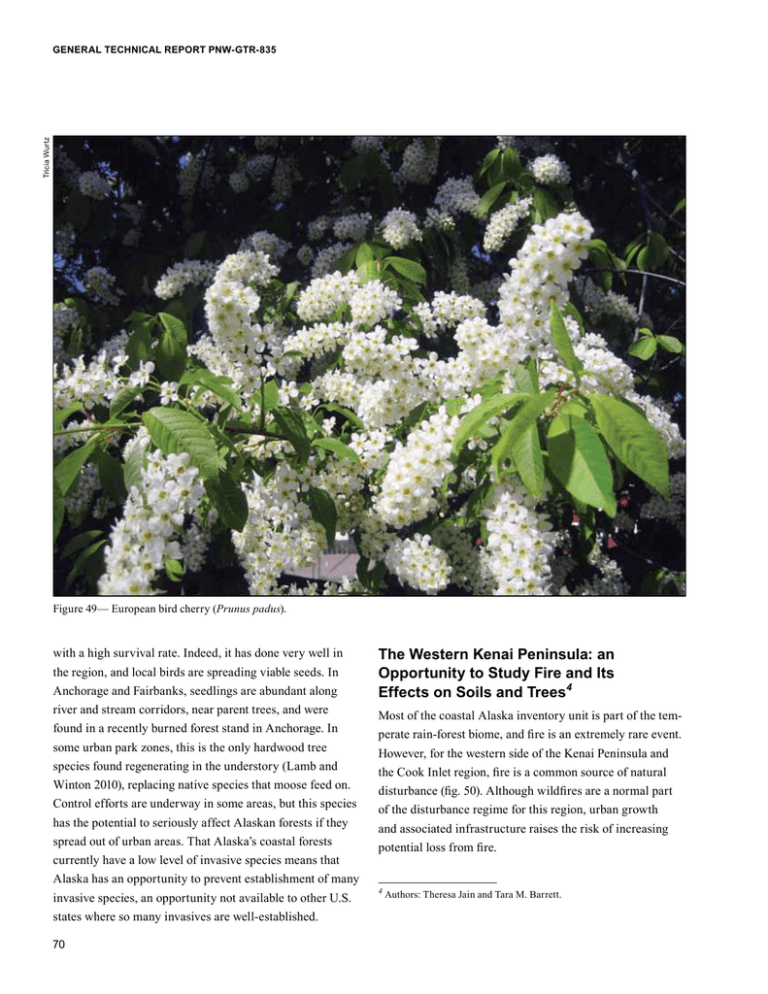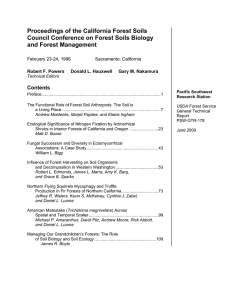The Western Kenai Peninsula: an Opportunity to Study Fire and Its
advertisement

Tricia Wurtz GENERAL TECHNICAL REPORT PNW-GTR-835 Figure 49— European bird cherry (Prunus padus). with a high survival rate. Indeed, it has done very well in the region, and local birds are spreading viable seeds. In Anchorage and Fairbanks, seedlings are abundant along river and stream corridors, near parent trees, and were found in a recently burned forest stand in Anchorage. In some urban park zones, this is the only hardwood tree species found regenerating in the understory (Lamb and Winton 2010), replacing native species that moose feed on. Control efforts are underway in some areas, but this species has the potential to seriously affect Alaskan forests if they spread out of urban areas. That Alaska’s coastal forests currently have a low level of invasive species means that Alaska has an opportunity to prevent establishment of many invasive species, an opportunity not available to other U.S. states where so many invasives are well-established. 70 The Western Kenai Peninsula: an Opportunity to Study Fire and Its Effects on Soils and Trees4 Most of the coastal Alaska inventory unit is part of the temperate rain-forest biome, and fire is an extremely rare event. However, for the western side of the Kenai Peninsula and the Cook Inlet region, fire is a common source of natural disturbance (fig. 50). Although wildfires are a normal part of the disturbance regime for this region, urban growth and associated infrastructure raises the risk of increasing potential loss from fire. 4 Authors: Theresa Jain and Tara M. Barrett. Kenneth C. Winterberger Forests of Southeast and South-Central Alaska, 2004–2008 Figure 50—Fires on the Kenai Peninsula, 1946–2009. Source: Monitoring Trends in Burn Severity database (http://mtbs.gov/). Projection: Alaska Albers NAD 83. 71 GENERAL TECHNICAL REPORT PNW-GTR-835 Understanding how the forest environment is affected by fire is helpful for predicting how the ecosystems in the Cook Inlet and western Kenai may change in the future. Fire effects include impacts on the soil as well as impacts on the trees and other vegetation. A soil’s physical (appearance and mineralogy), chemical (nutritients), and biological (soil fauna) states after a fire are dependent upon the amount and duration of heating, prefire environmental conditions, landscape attributes, and fire-suppression tactics. The primary soil physical properties affected by fire are water repellency, structure stability, texture, color, temperature, and abundance of surface organic matter (Certini 2005). The chemical properties include the abundance of organic carbon, cation exchange capacity, nutrient levels and availability, and pH. However, the quantity, composition, and quality of the surface and mineral soil organic layers (leaves, needles, humic substances) are also important for influencing chemical properties. The biological properties include fungi, bacteria, soil-dwelling invertebrates, plant seed, roots, bulbs, root crowns, and other plant materials needed for sprouting or regeneration. All these components influence factors such as erosion, wildlife habitat, soil productivity, and vegetation recovery. Soil physical properties— Erosion is a common postfire effect because of its influence on water quality and the potential for flooding. In most circumstances, erosion does not occur unless the surface organic matter (litter, root mat) cover is less than 30 percent (Lewis et al. 2006). However, if the appropriate prefire soils exist (such as granitics), water repellency (inability for the soil to absorb water) can occur at relatively low temperatures that are quite common in wildfires (177 to 204 °C) when duration is greater than 15 minutes (Debano et al. 1976). Lewis et al. (2006) reported that grey ash is more characteristic of potential water repellency than the presence of black ash. Morever, if the overstory is killed in the fire and the forest floor is no longer present, soil temperatures can increase. 72 Soil chemistry— The highest proportion of soil nutrients exist within the surface organic matter, upper mineral soil layers, and wood residue (surface and buried rotten wood). Harvey et al. (1989) reported that up to 56 percent of the nitrogen occurs within the litter and humic layers, upper mineral in the first 2 inches, and wood residue. During a fire, these components are also the most vulnerable to loss through combustion. For example, nitrogen, a nutrient that is frequently limiting in forest environments, can volatilize at 752 °F (Hungerford et al. 1991). However, nutrients such as potassium do not volatilize until temperatures exceed 1293 °F (Hungerford et al. 1991). Soil biology— Many organisms do not survive temperatures greater than 140 °F. Pollen, seeds, spores, lichens, and mosses do not survive above 284 °F when exposed to these temperatures for more than 30 minutes. Even lower temperatures (158 °F) can cause mortality if exposure exceeds 4 hours (Levitt 1980). Wingless insects die when exposed to temperatures greater than 104 °F. Mammals, when exposed to the temperatures directly, cannot survive when temperatures exceed 140 °F. Ninety percent of the microbial carbon in soils is volatized when exposed to temperatures of 572 °F for longer than 15 minutes (Levitt 1980). A fire can kill vegetation two ways, through direct combustion, such as in a crown fire, or through radiant heat, which causes needle or crown scorch (red needles). Radiant heat from smoldering fires can kill roots or damage the tree cambium; this type of mortality is typically delayed and therefore a tree that appears alive after the fire can die over time. In addition, if a tree survives a fire, it sometimes can become stressed, allowing for mortality to occur from insects or disease. How quickly a forest recovers after a fire is dependent on three survival mechanisms: whether vegetation survives a fire (e.g., ponderosa pine), recolonization either from seed banks in the soil, or transported to the site (e.g., wind, animals, floods), or sprouting new growth from roots. Each Forests of Southeast and South-Central Alaska, 2004–2008 Therefore, it is critical that each forest type be evaluated as to the relation between the postfire environment and how quickly a forest recovers. The FIA program of the Pacific Northwest Research Station maintains a permanent sample of plots located on a grid throughout the United States; this provides unique information on the extent and severity of fires in forest lands as well as on postfire recovery and succession. In the Western United States, FIA has begun measuring postfire impacts on soil and vegetation the year after a fire. This information, when combined with long-term remeasurements over succeeding decades, can help us understand the trends and variation in fire effects for different forest types ranging from ponderosa pine forests of the interior West, to mixed-conifer forests of the Sierra Nevada, to the boreal forests of Alaska. Tara M. Barrett forest is different as to how it recovers after a wildfire. If a forest is able to recover quickly with much of its original plant composition, the forest is considered resilient. However, if after a wildfire, the soils no longer have seed, or an introduced species occupies the site, the forest may be less resilient (fig. 51). The level to which a forest can recover after a fire is dependent on the soils, the forest composition, and other factors that may influence how a fire burns a particular site. For example, white spruce produces large seed crops after a hot dry summer; black spruce has semiserotinous cones that open when exposed to heat; aspen, with its copious root systems, can sprout after a fire; and birch has seeds that disperse long distances. However, all forests are unique—thus what we learn in other parts of the United States does not always transfer to Alaskan forests. Figure 51—Liverworts, mosses, horsetails, and an invasive cherry seedling (Prunus padus, circled) sprout during the spring following the 2008 Piper Fire in Anchorage, Alaska. 73 GENERAL TECHNICAL REPORT PNW-GTR-835 The Distribution of Hemlock Dwarf Mistletoe Suggests Influences of Climate5 Background Hemlock dwarf mistletoe (Arceuthobium tsugense [Rosendhal] G.N. Jones) is an important disease of western hemlock in old-growth forests throughout southeast Alaska (fig. 53). The disease is caused by infection from a small higher plant, which is well-adapted to life as a parasite. When intensely infected, western Paul Hennon In Alaska, we used postfire protocols that were first implemented on FIA plots following the 2007 Caribou Hills wildfire, a human-caused fire that burned approximately 50,000 acres on the Kenai Peninsula. This was an area that had previously been affected by a bark beetle epidemic on the Kenai Peninsula that began in the late 1980s and continued into the 1990s. Warmer temperatures had increased overwinter survival and shortened maturation time for beetles (Berg et al. 2006), and increased summer temperatures may have also caused drought stress in trees, favoring successful beetle attacks. Preliminary results from the FIA plots burned in the Caribou Hills wildfire show that most trees that had survived the bark beetle epidemic were killed by the fire (fig. 52). The Caribou Hills wildfire provides an example of how complex interacting factors determine how forests change over time in the south-central region of Alaska. Warmer temperatures encourage beetle outbreaks, increasing the abundance of dead fuel, which in turn may increase the frequency of wildfires. The frequency and extent of wildfires is also affected by the increasing development in the region. Active fire suppression in populated areas contributes to fuel buildup, and fire ignitions increase with human activities. Changes in the fire regime resulting from these interactions may potentially alter the path of succession in these areas (Kasischke et al. 2000). Figure 53—Western hemlock killed by hemlock dwarf mistletoe, resulting in a canopy gap in an old-growth forest. Note the numerous witches’ broom infections on the branches of the dead tree. Eric Straley hemlock trees suffer significant growth loss, reduced wood quality, and higher rates of mortality. Branch infections result in abnormal growth proliferations known as “witches’ brooms” that can serve as important wildlife habitat. Depending on management goals, foresters can achieve various levels of infected trees in managed stands by manipulating harvest regimes, ranging from eradication to numerous infected trees (Muir and Hennon 2007). Clearcut harvests greatly reduce or eliminate the disease, whereas retention harvests that maintain large, dispersed infected trees encourage it. Figure 52—Dead white spruce and regenerating understory vegetation on the Kenai Peninsula 1 year after the 2007 Caribou Hills Fire. 74 5 Authors: Paul Hennon, Tara M. Barrett, and Dustin Wittwer.




